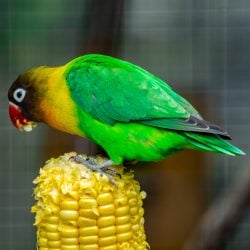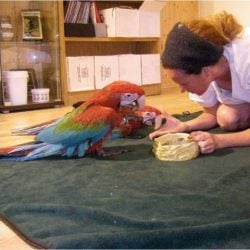Last Updated on by Mitch Rezman
It’s important to review egg-laying problems on a regular basis.
The discussion below will focus on single egg-laying instances and prolific egg-laying.
Other aspects of egg-laying encompass egg binding.
This is when the egg doesn’t make it out of the oviduct, the area between the uterus and cloaca on its own.
Another problem is when eggs are laid internally.
Starting with the left abdominal air sac surrounding infundibulum or the opening of the oviduct.
An opportunity may present itself where the egg may fall into the opening of the infundibulum miss and laid in the coelomic cavity.
The hen may simply absorb the egg or get peritonitis, where yolk material is found in the coelomic cavity.

Having solutions to prevent your pet bird from laying eggs is like having an insurance policy, protecting her health.
For more than 120 million years, birds got along quite well without human intervention.
We know for certain that during that time period, the sun rose and set approximately every 12 hours in the area 40 minutes north in 40 minutes south (latitude) of the equator where most “exotic birds” are indigenous to.
It’s no surprise that many pet birds in captivity exhibit negative behavior like aggression and feather self-mutilation.
There is a universal quest seeking answers and solutions like CBD oils and misting sprays which is all well and good but still works against the grain within your parrot’s brain.
That’s because the light flowing in through your home’s windows is feeding your bird bad data that is being interpreted by the pineal gland behind the right eyeball.
“Bad data” you ask?
Yes, that light is getting dark at the wrong times and confusing your bird.
Your bird’s brain is not understanding why it’s dark at five when there still should be three more hours of light.
That simple signal throws your bird’s instinctual expectations into turmoil.
The turmoil results and stress triggers negative behavior just like in humans.
When humans get stressed they may turn to drugs alcohol or gambling – negative behavior.
A bird has fewer choices so it may get aggressive out of confusion or self-mutilate (as seen in humans too).
The fix?
Change the data.
It’s not the light source it’s the light cycle.
Supply the correct light cycle you’ll see a rapid improvement in your bird’s behavior.
It is incredibly important to shut down the reproductive system of a chronic egg-laying bird.
It creates an enormous health risk by demanding calories for the production of eggs while depleting calcium.
When this happens during a molt the bird is under double the stress physically to me all its nutritional needs.
There are certain protocols follow when you have a chronic and laying bird or even a hen displaying hormonal activity.
- Anything resembling a nesting area must be removed or blocked.
- No empty boxes, no crawling under the couch, no crawling under blankets on the sofa.
- You can stroke your bird but only from the neck up. Stroking a bird’s back and/or the beak will sexually stimulate her.
- If the bird lays eggs remove them immediately, adding fake eggs will only encourage brooding activity.
Birds have more than 120 million years of instinctual expectations.
One of those instinctual expectations is a 12 hour light cycle coming from an equatorial region on earth typically 40° North and 40° south of the equator.
In order to compensate for this, we install a light no more than 6 inches above the cage.
In order to break the egg-laying cycle, the bird must be placed in the cage for a minimum of 72 hours with the light on 100% of the time.
This is not inhumane, the birds have eyelids and are able to sleep.
You can cover the cage at night but make sure the cover goes on top of the lights of the light is shining down upon the bird.
During the day provide plenty of fresh water but just enough food in the dish to satisfy her normal food capacity.
While under the light for 72 hours take all food out of the cage for each night.
Birds are smart enough to realize that without abundant food it’s not a good idea to make babies.
During the 72 hours of light, we have reset the bird’s circadian rhythm (one of several).
After the 72 hours, the light must be put on a timer for 12 hours of light and 12 hours of darkness year round to keep the bird circadian rhythm synchronized with its body.
If you have further questions feel free to reach out.
References
The Hagen Avicultural Research Institute
Chronic Egg-laying What You Can Do | Harrison’s Bird Foods
(We respectfully disagree with hormone injections due to the lack of long term research)
I was hoping you could help me with this.
I couldn’t really find any answers on the internet.
I have a bunch of parakeets.
I have a pair that mate and have babies.
They currently have new eggs in the nesting box inside their cage with two that actually hatched.
I looked inside the box today and noticed that the younger of the two babies that hatched had died.
The other baby is beginning to get feathers.
My question is, do I leave the dead baby inside the nesting box until the other baby comes out or can I open the top of the box and take the dead baby out without disturbing the other baby and potentially making the mama parakeet not want to go in the box to feed the other baby?
Not sure what to do.
Please help if you can.
Thanks so much.
Linda
Dear Linda
We need to take control of this situation, immediately.
Remove the box, empty everything out of it, wipe it as clean as you can, and put new pine shavings in it and the remaining living babies and put it back in the cage.
The new eggs, dead babies and dirty nesting material all go into the garbage.
Allow the birds to finish tending to the babies or pull them to hand feed them yourself.
Then get the nest box out of the cage and stop the madness.
It is out of control and not healthy for the birds to be nesting constantly.
Next, end the breeding and nesting period by correcting their lighting so they can stop being hormonal.
Put a light fixture as close to the top of their cage as possible and put it on a timer so the light goes on at approximately 8 am and off at 8 pm. (see video above)
Get a full spectrum bulb, anywhere. But we do have them here. Economy Bulb
This lighting should help regulate their hormones and get them to stop producing eggs and mating.
If it does not stop (from now on NO NEST BOX) and they lay eggs on the cage bottom or in food dishes, remove them and toss.
If they keep laying eggs then you need to do a Light Treatment to get them to stop.
You would instead of turning the light off after the 12-hour cycle, you would instead leave the light on for 72 hours.
That is a solid 3 days and nights with the light on over the cage.
This resets the pineal gland in their brains that manages the circadian rhythm that tells them when to breed.
After the 3 days and nights of solid lights on, they should stop breeding.
Your birds should settle down and just enjoy being birds again.
If breeding resumes after the 3-day treatment (give them a few days to see first) then you can do a light treatment for 7 days.
After that, they should be good to go.
I also recommend that you rearrange the inside of the cage, move all the perches around, move the toys around, move the food and water dishes if possible.
Plus, cut back on the food in the dishes.
Give only enough to get to the next day.
An overabundance of food causes birds to feel they have plenty of food so let’s raise a family.
Are you giving your birds a calcium supplement?
Calcium for the eggshells comes from their bodies and it must be replenished.
Here are a couple of options.
Please implement these instructions and let us know how it goes.
Barbara G writes to Mitch, Catherine
For whenever you have time………I was called and asked an odd question today.
I don’t know all the specifics of what happened but here’s the question.
Someone had a parakeet that laid eggs and then died.
I don’t know anything about the death or the parakeet’s mate.
The owner says that some of the eggs are still viable and he’s keeping them warm and wanted to know if there was anyone who would like to have them so that they weren’t all lost.
Sad since the parakeet probably could have been saved.
Anyway, I promised that I would try to find out the correct answer to this.
You have more contacts than anyone I know in the bird world so I’m sending this question to you.
Also, is Star/Bagel thriving?
I hope so. Hope all the others are too.
Tell him I still love him.
Barbara G
Catherine to Barbara, Catherine, cc: Mitch
Barbara
Good to hear from you.
When I look at Bagel I often think of you.
[videopress EpBwYcEQ]
The Breakfast Club – Bacon – Eggs – Toast – Jam – Biscuit – Gravy – Chicken – Waffles – Bagel – Creamcheese
He has come a long way and seems to be the cage acrobat.
He loves to climb on the Olympic Ring toy and then try to contort himself to climb into the next ring above.
His body just can’t do that, but he continues to try.
So cute. He is a big eater, loves to swing.
He is easy to tell from the other blue parakeets as his markings are thin bars vs their larger black markings.
I have not taken any new pictures of Bagel, but when I do I will send them to you too.
Now the eggs.
I have no sources or know of anyone or any female bird that could take on the eggs.
If properly incubated by hand or machine the newborns would require even more diligent care, hourly feedings around the clock, cleanings, heat requirements. I could not undertake such a job.
At this point, they can just be allowed to cool off and stop developing.
My sympathies to the bird owner, caretaker.
Best
Catherine
Author Profile
Latest entries
 PigeonsJune 20, 2025How Do Parrots Thrive in Cities Outside Their Native Habitats?
PigeonsJune 20, 2025How Do Parrots Thrive in Cities Outside Their Native Habitats? Feeding Exotic BirdsJune 20, 2025Is Corn On the Cob Safe for Pet Birds?
Feeding Exotic BirdsJune 20, 2025Is Corn On the Cob Safe for Pet Birds? Bird & Parrot AnatomyJune 19, 2025Would You Like a Comprehensive Guide for Training Your Bird?
Bird & Parrot AnatomyJune 19, 2025Would You Like a Comprehensive Guide for Training Your Bird? Feeding Exotic BirdsJune 19, 2025Here Are Three (Video) Strategies to Help Your Bird Forage
Feeding Exotic BirdsJune 19, 2025Here Are Three (Video) Strategies to Help Your Bird Forage




